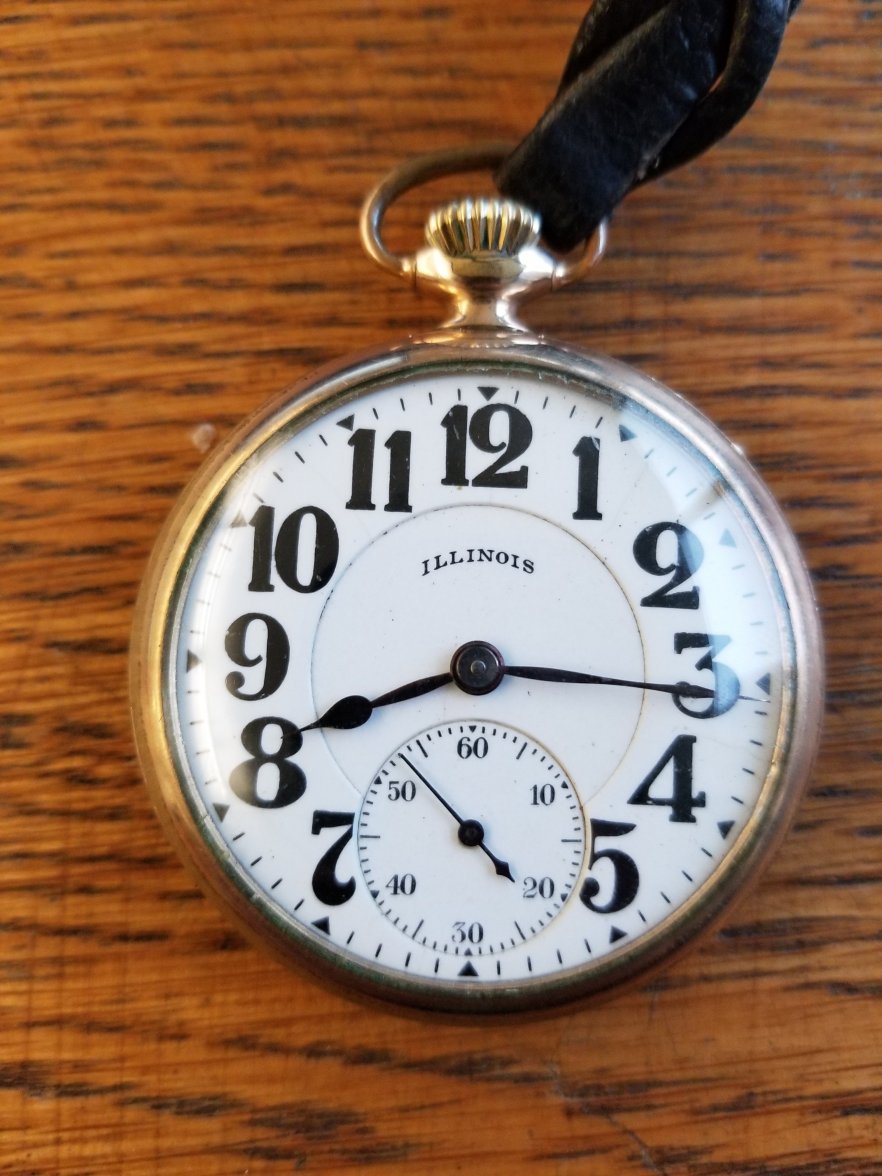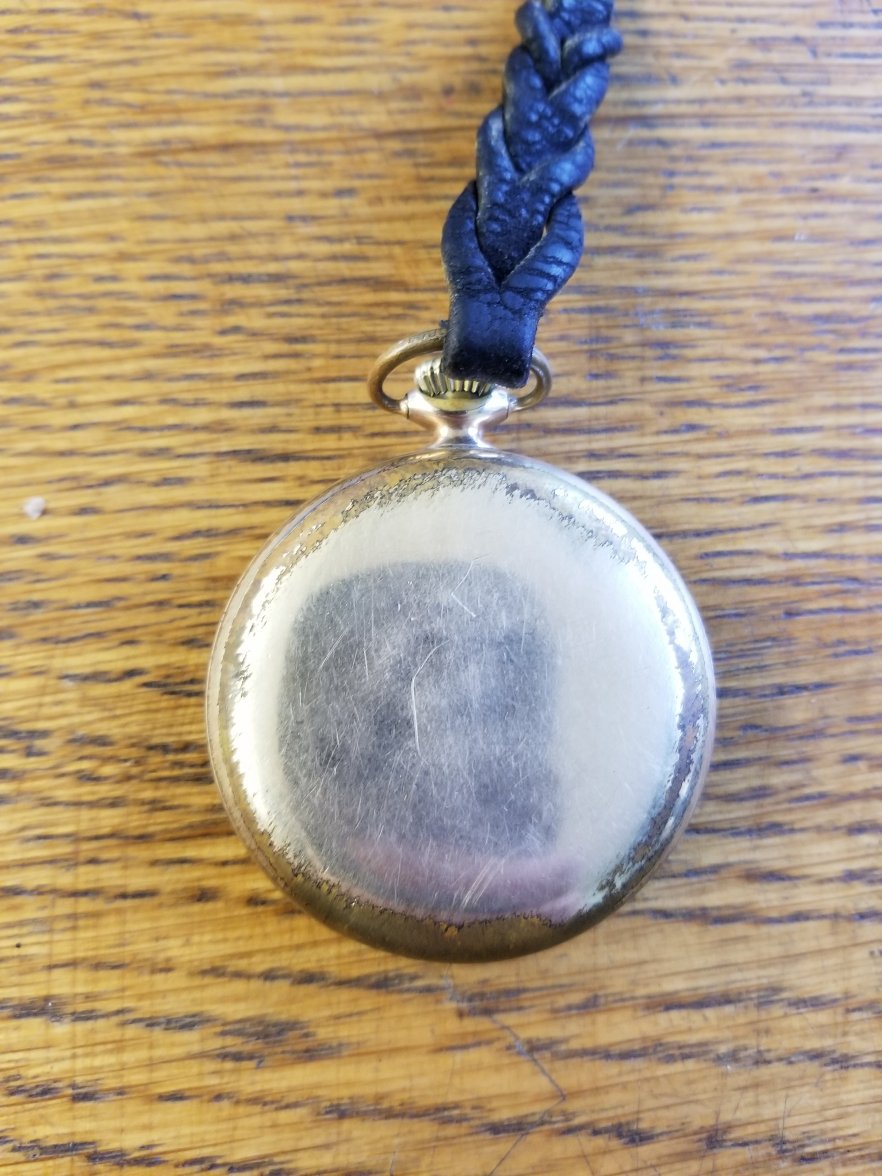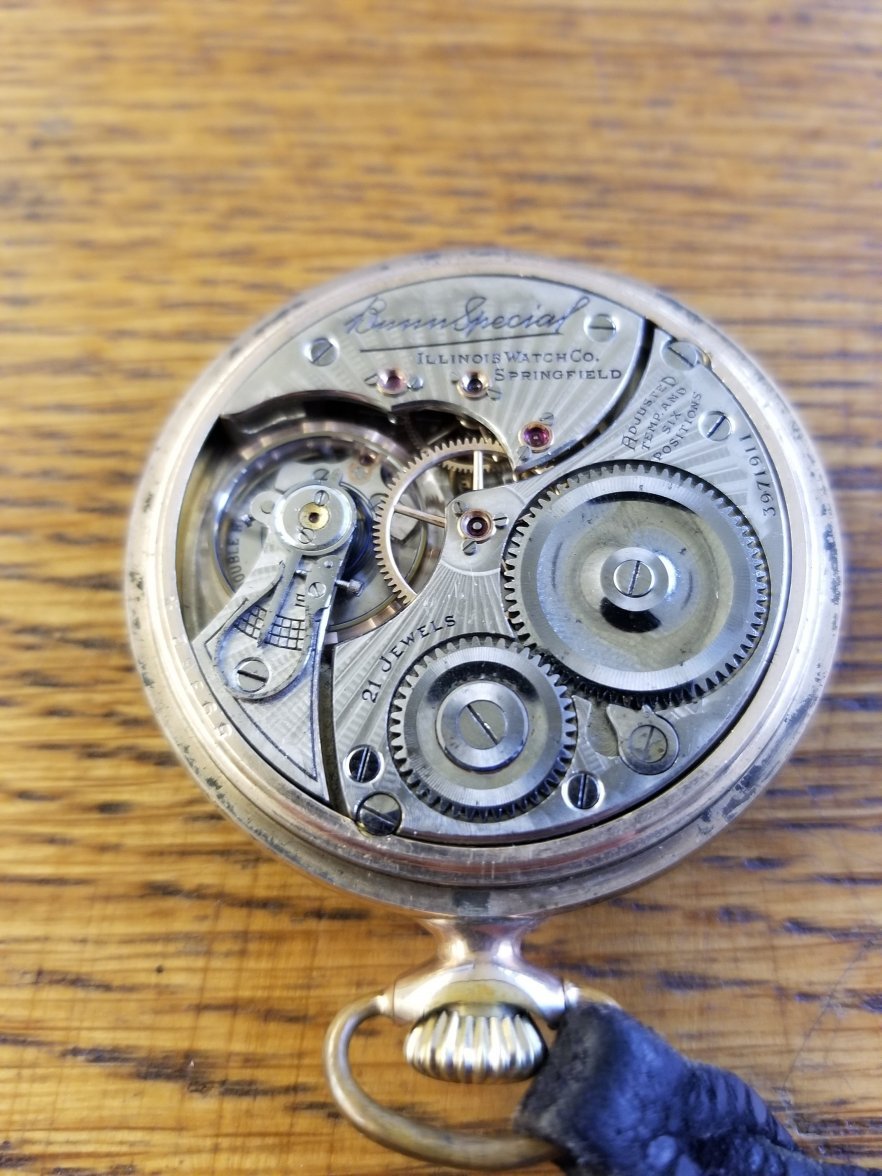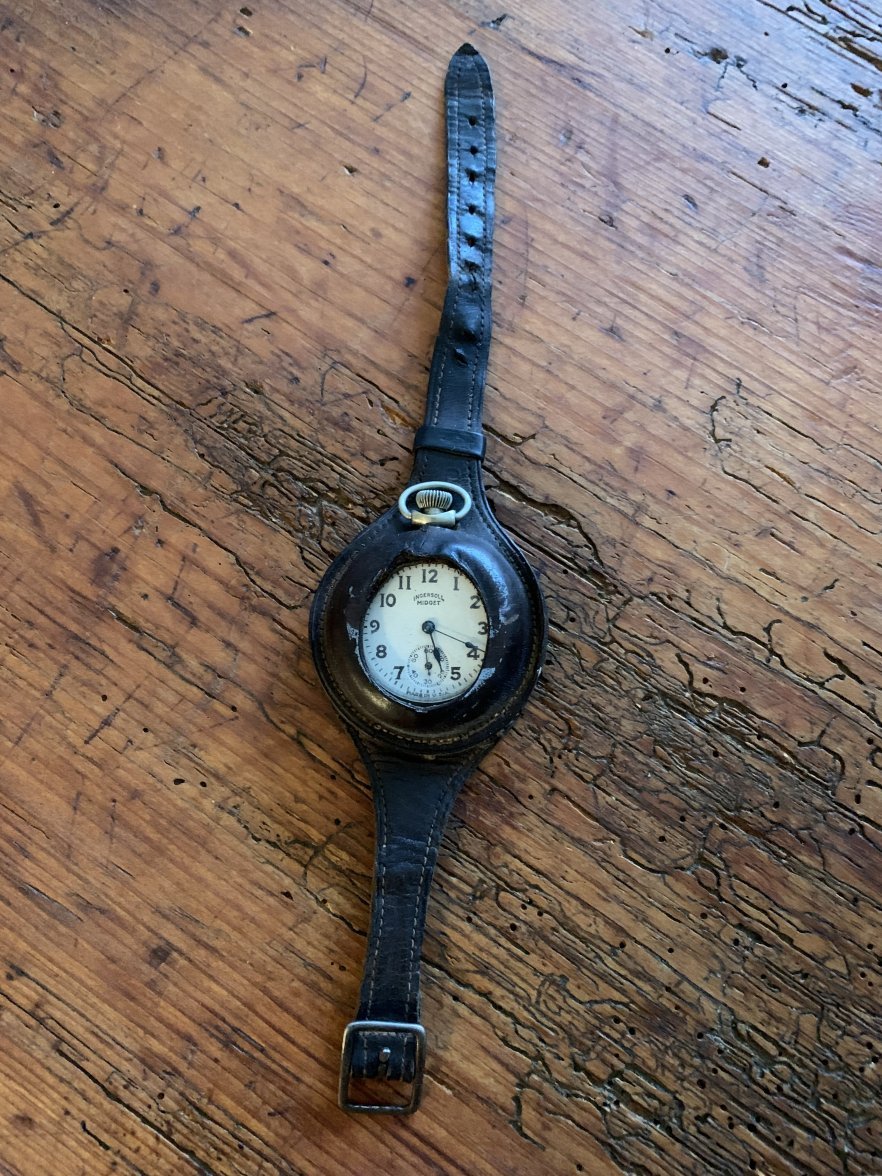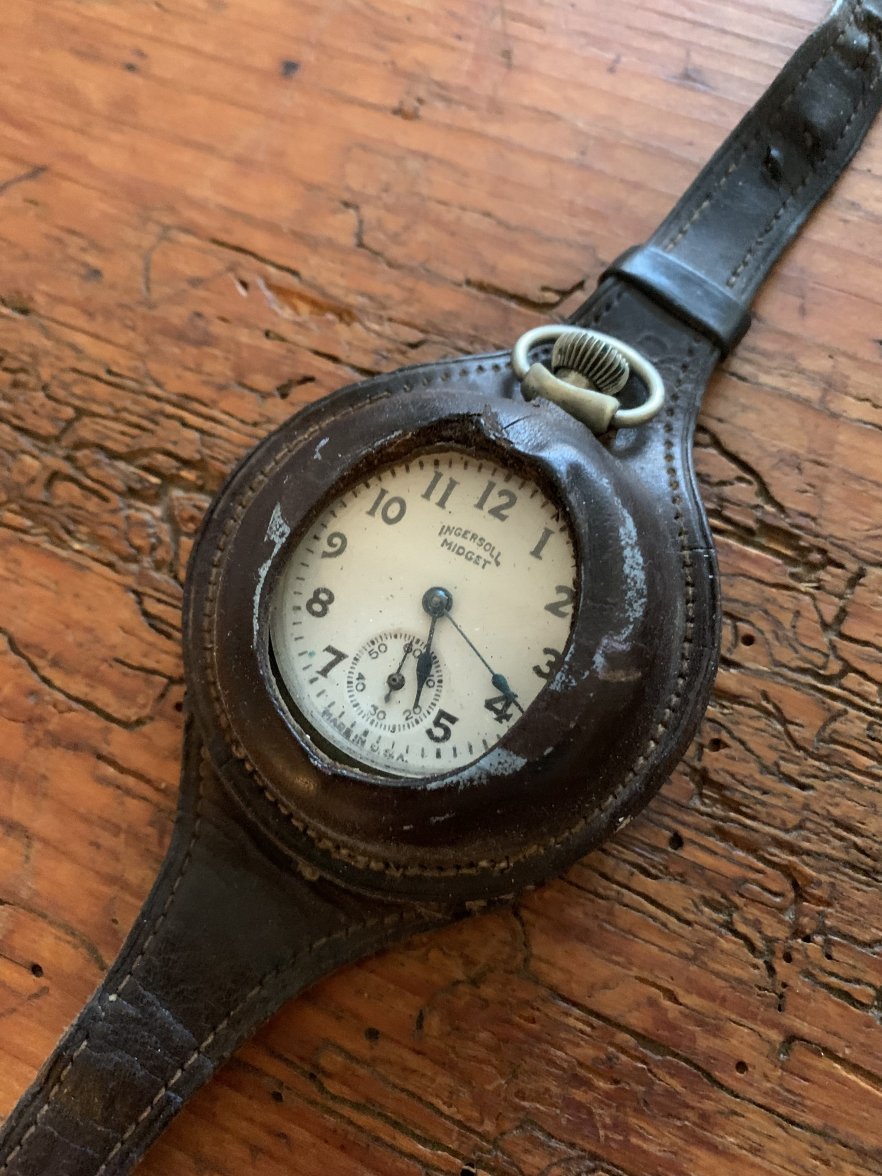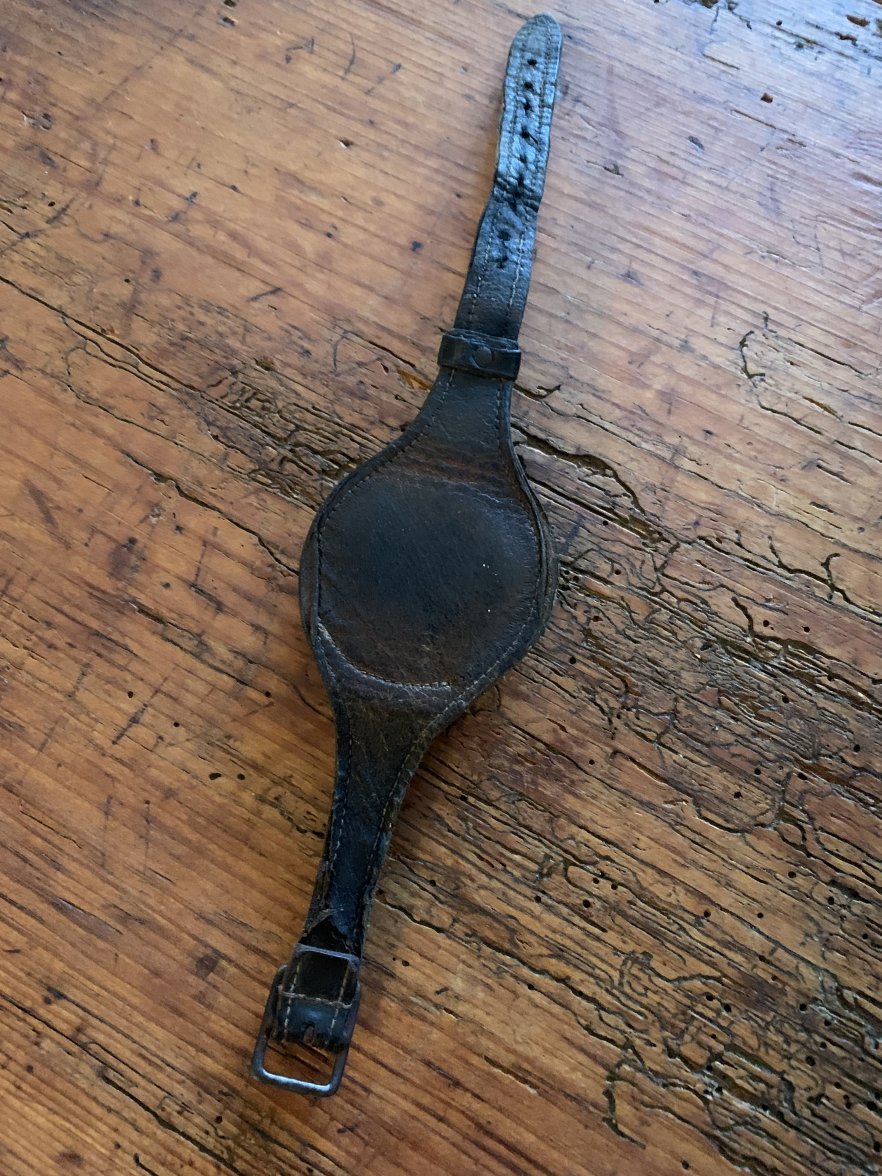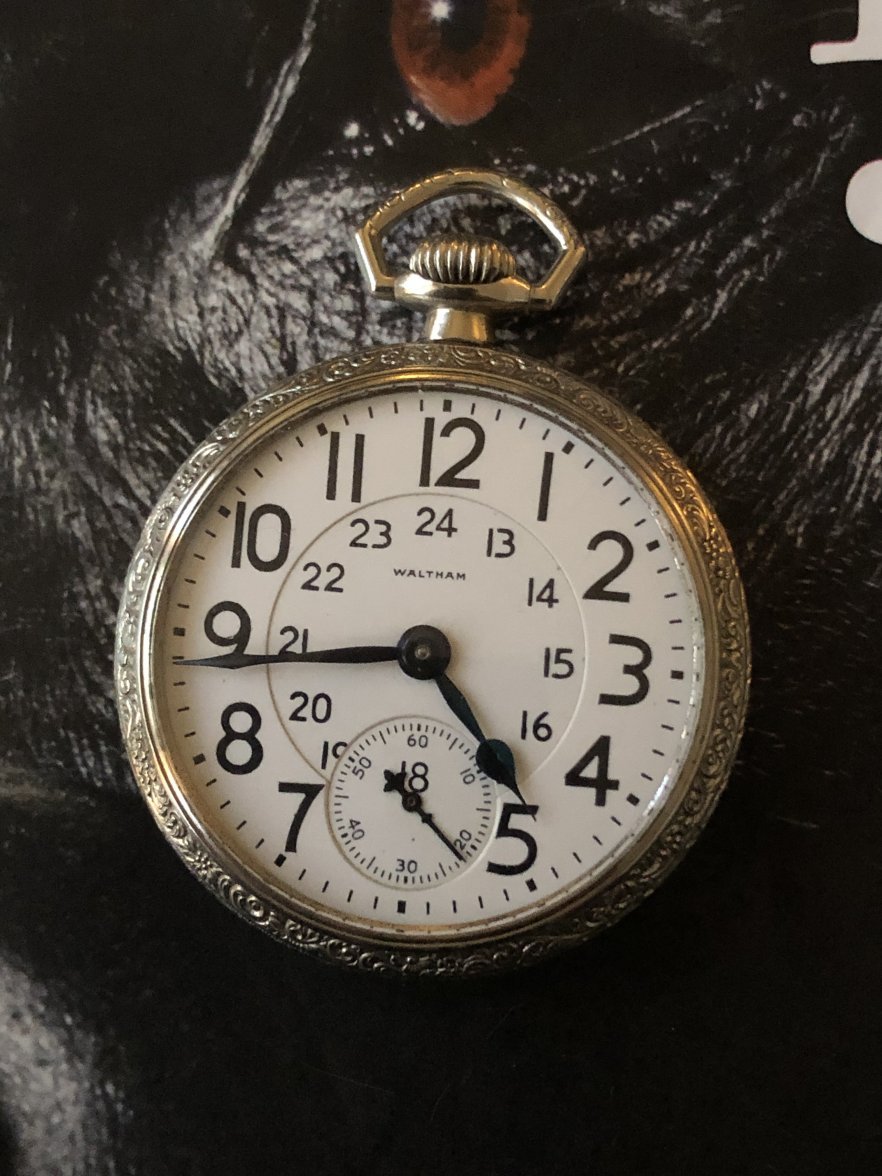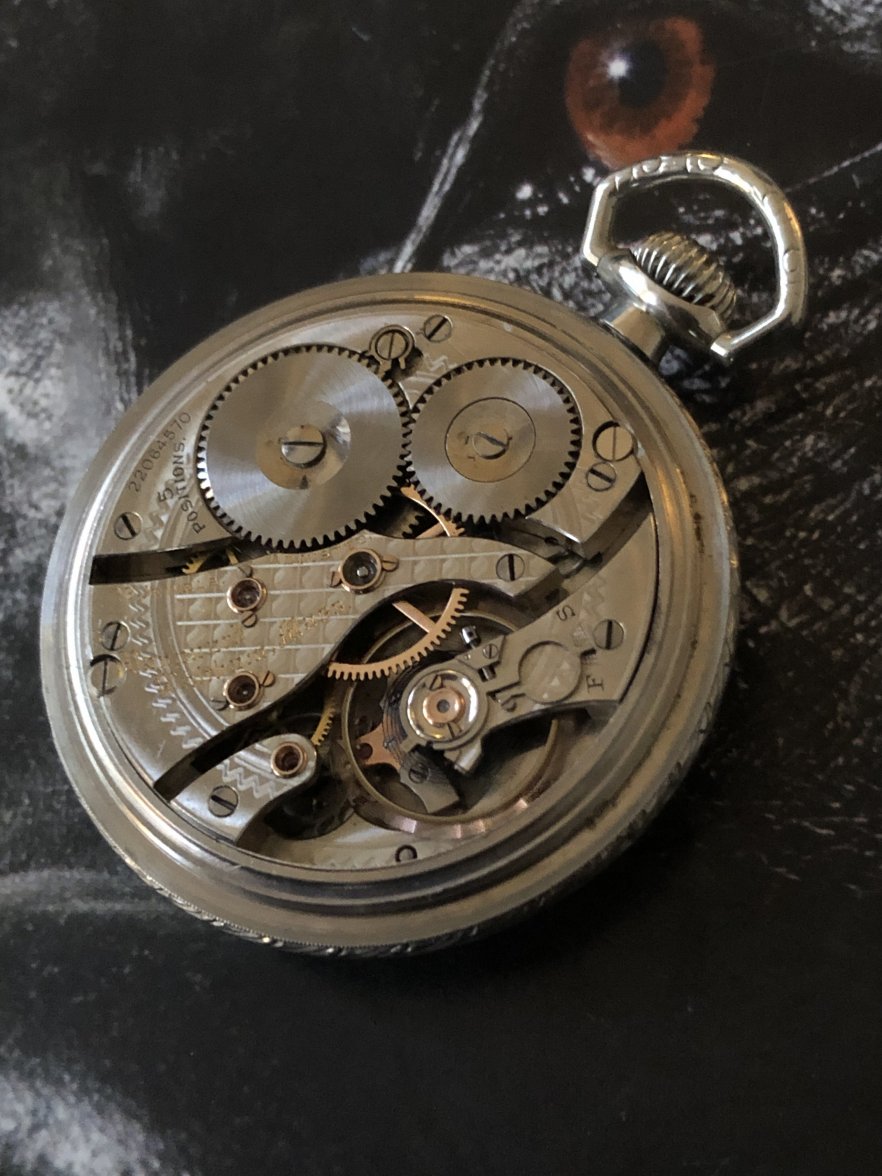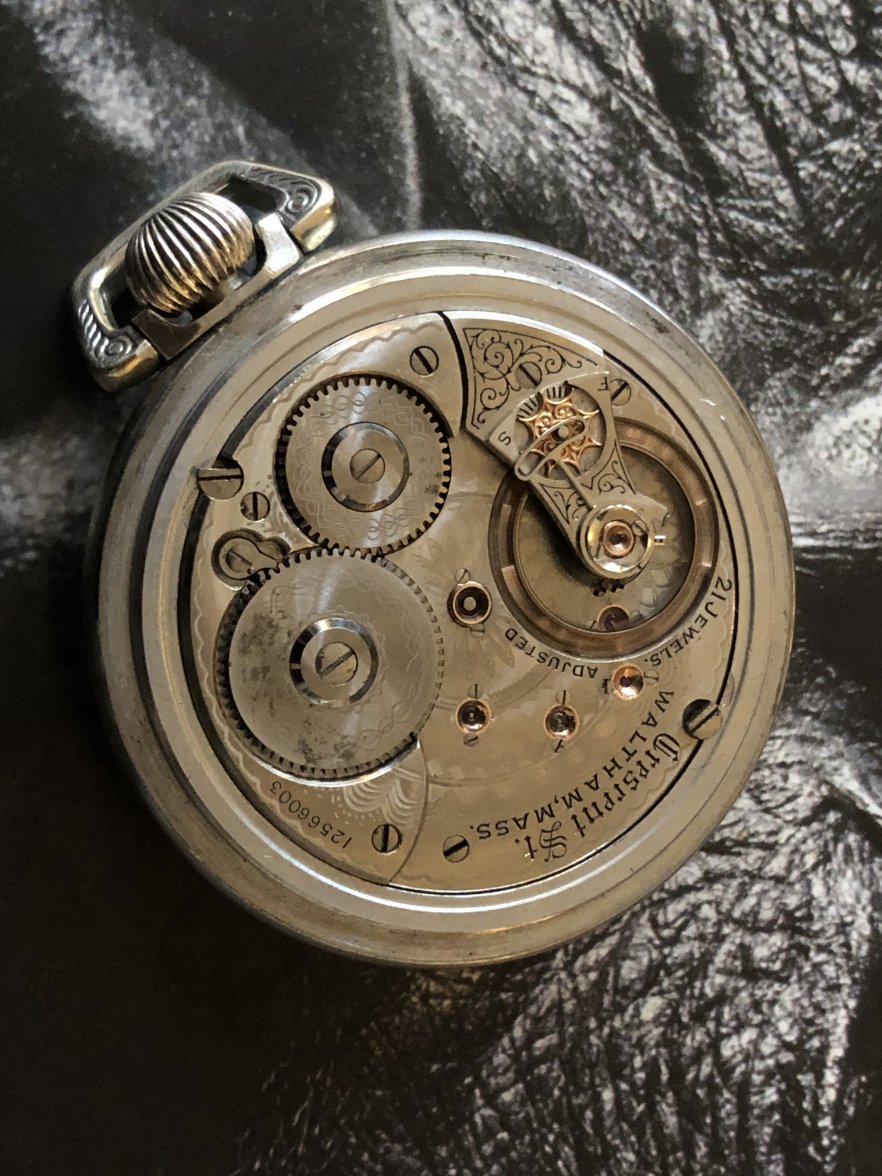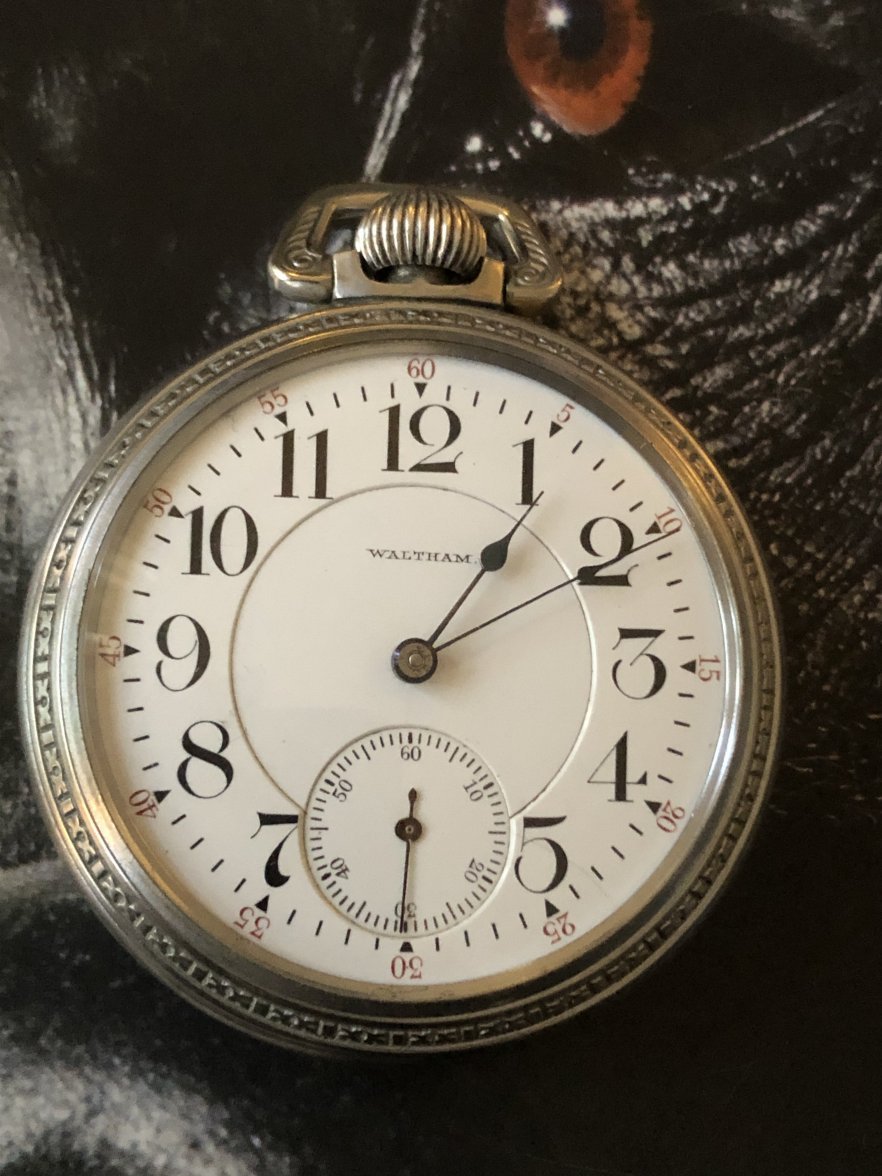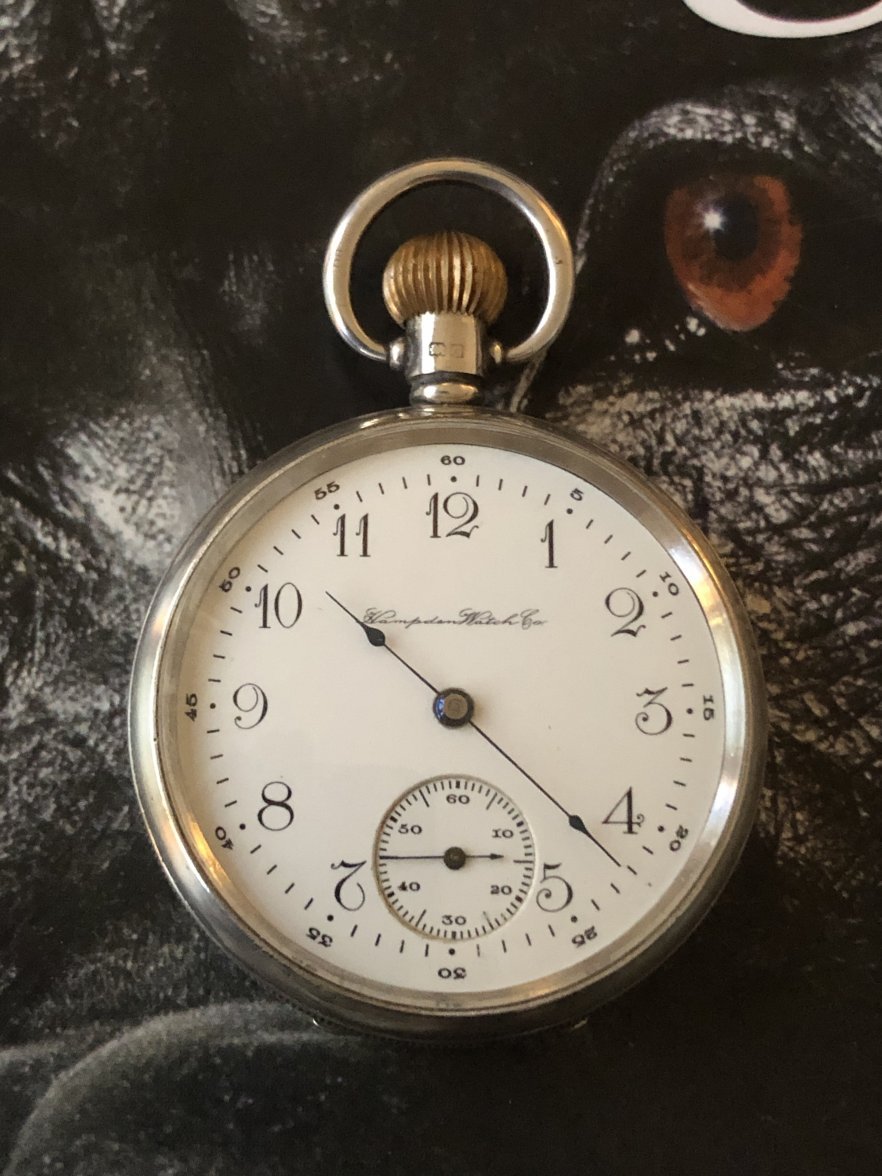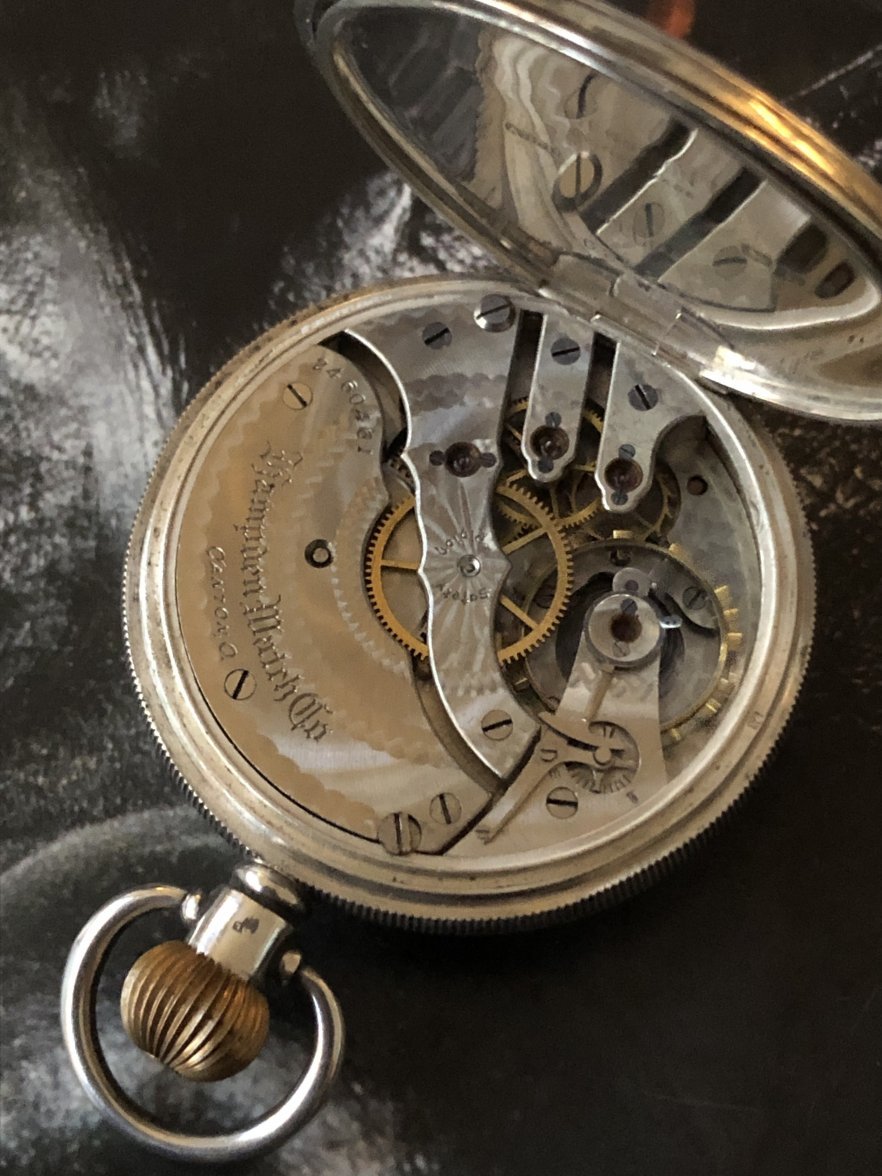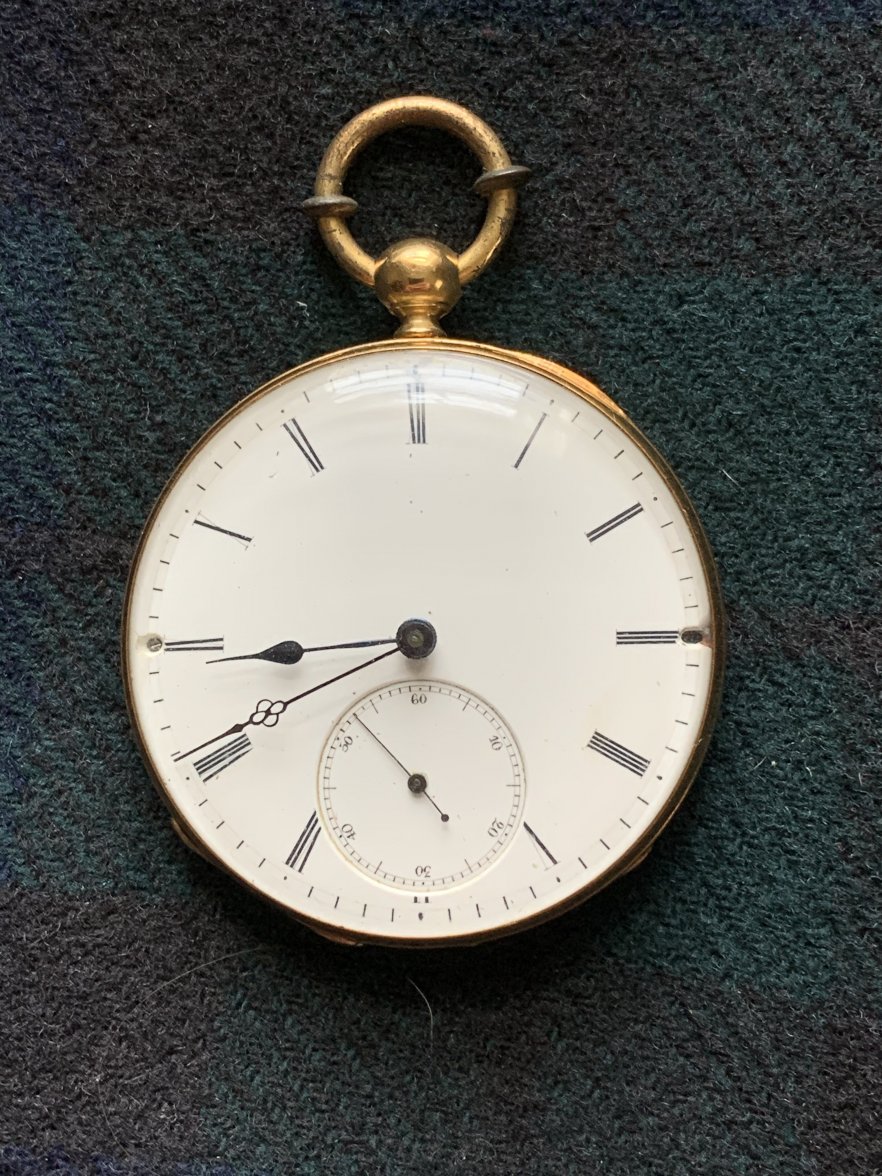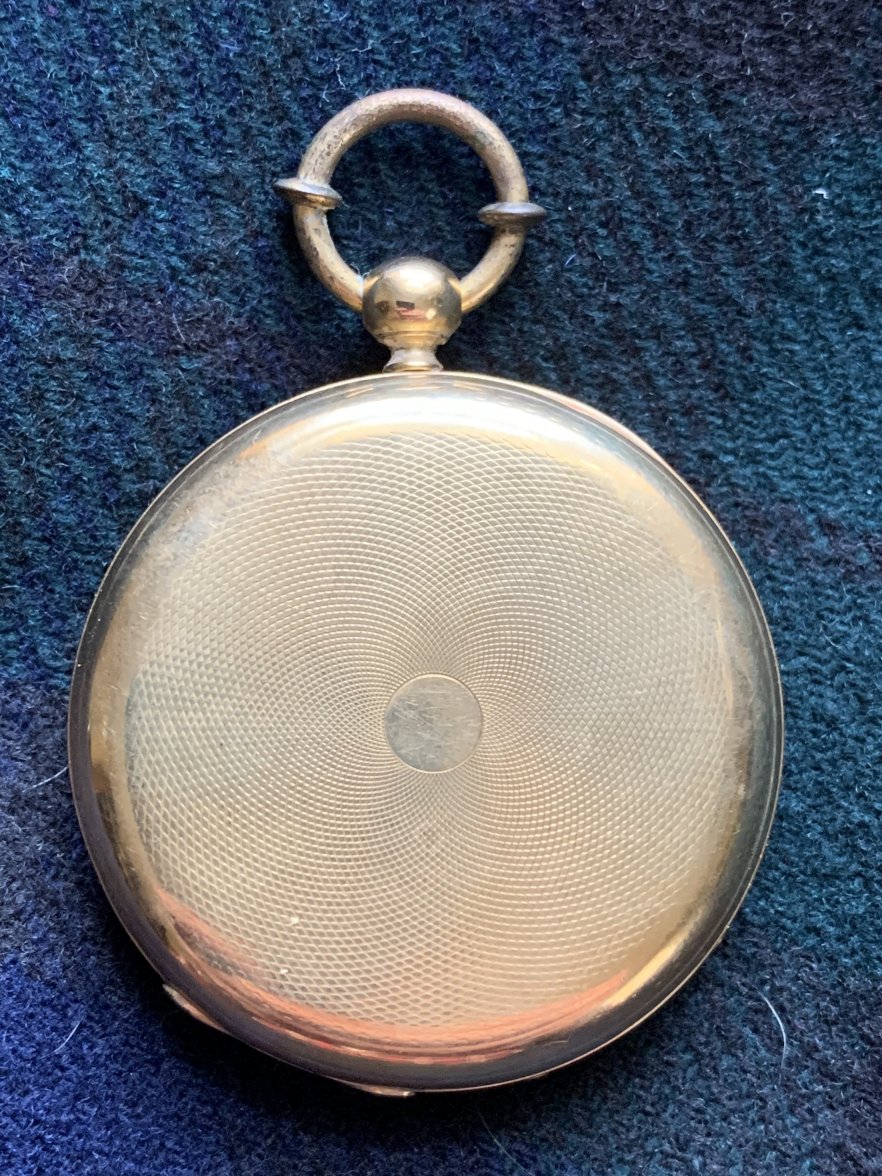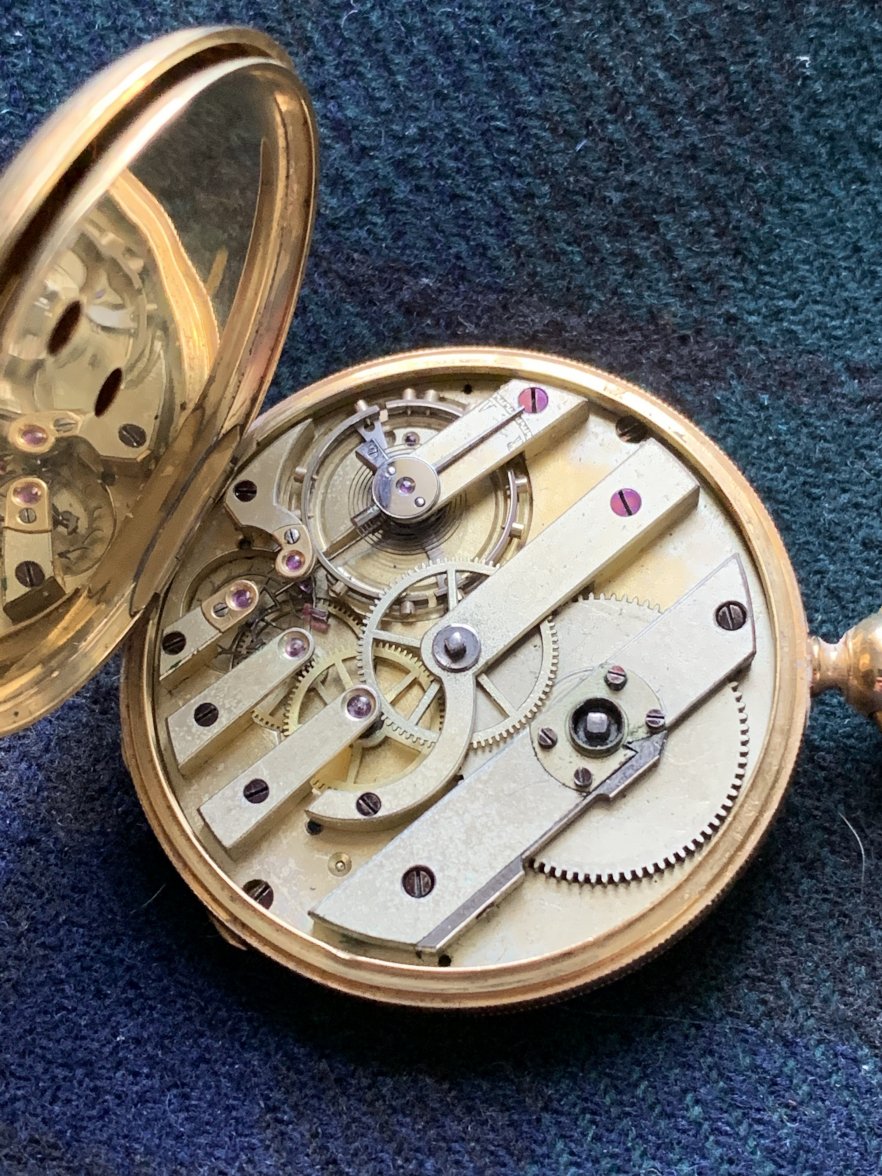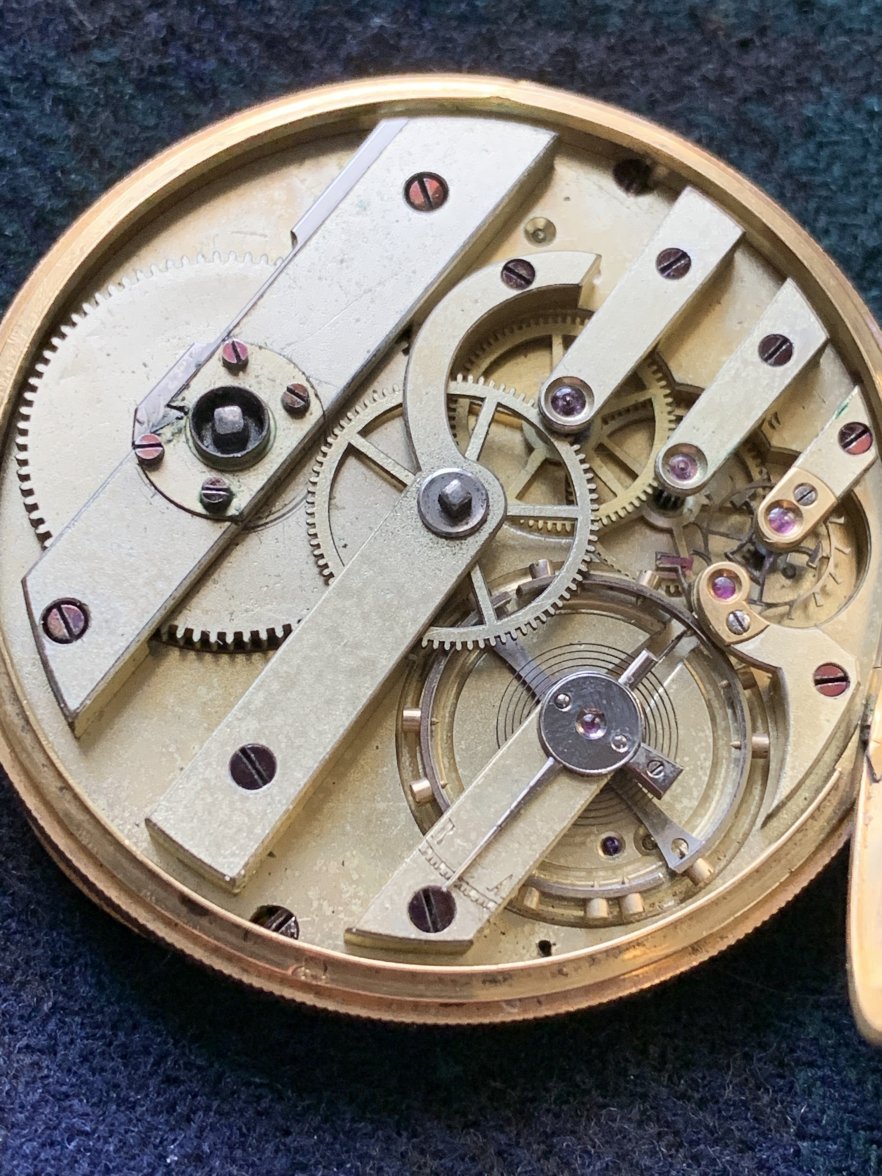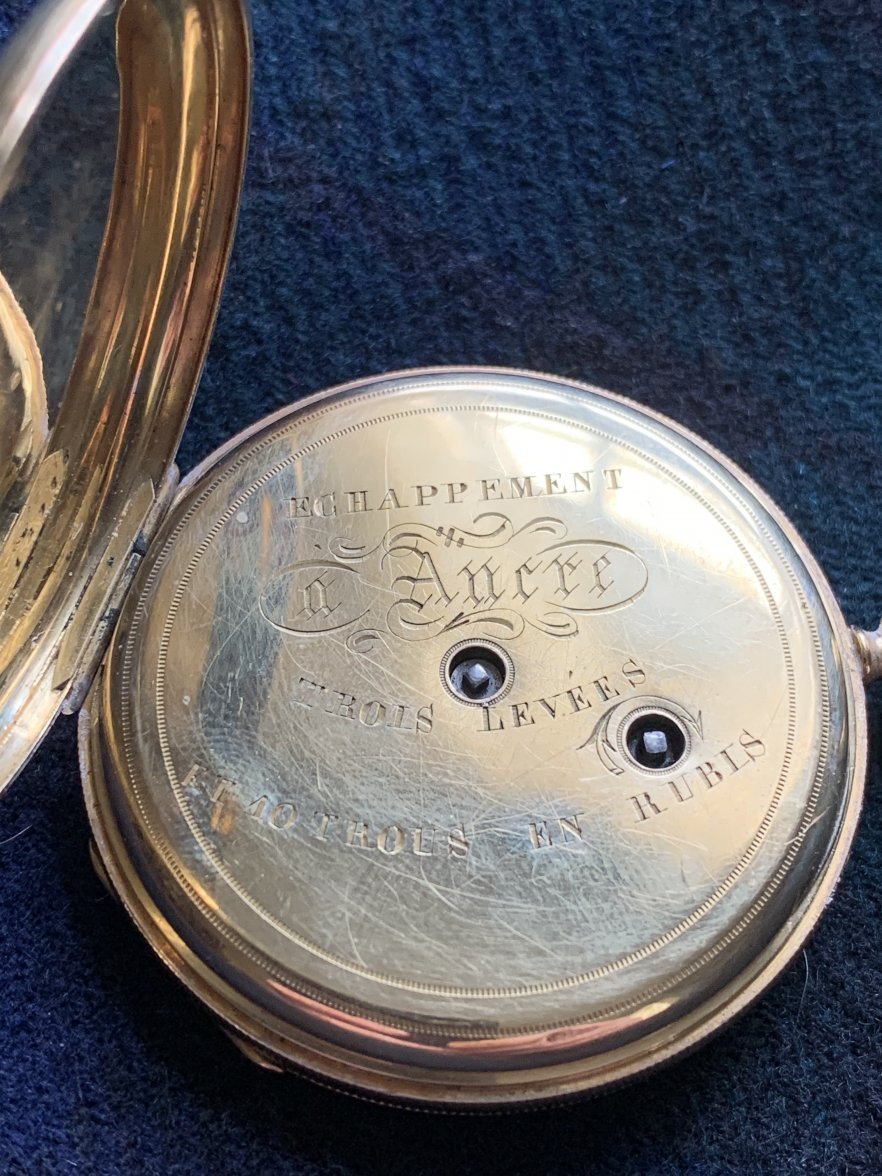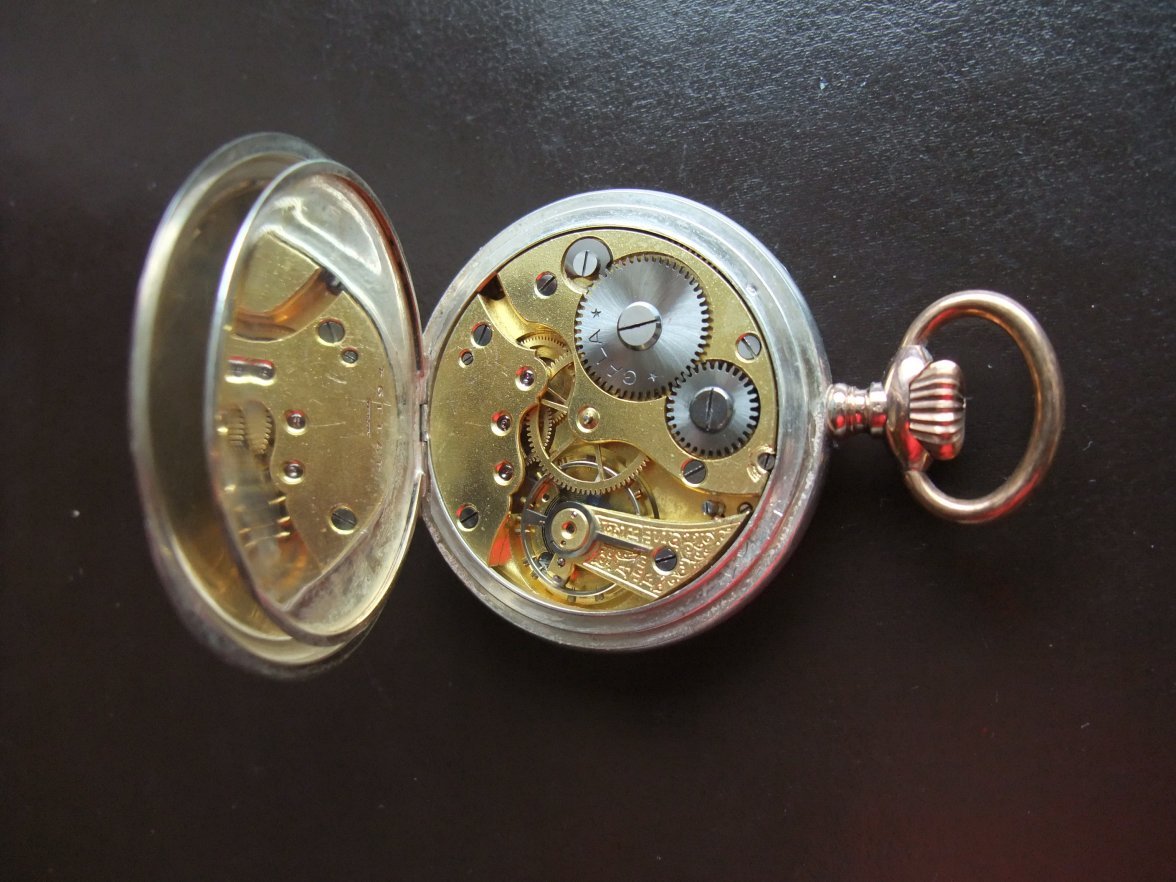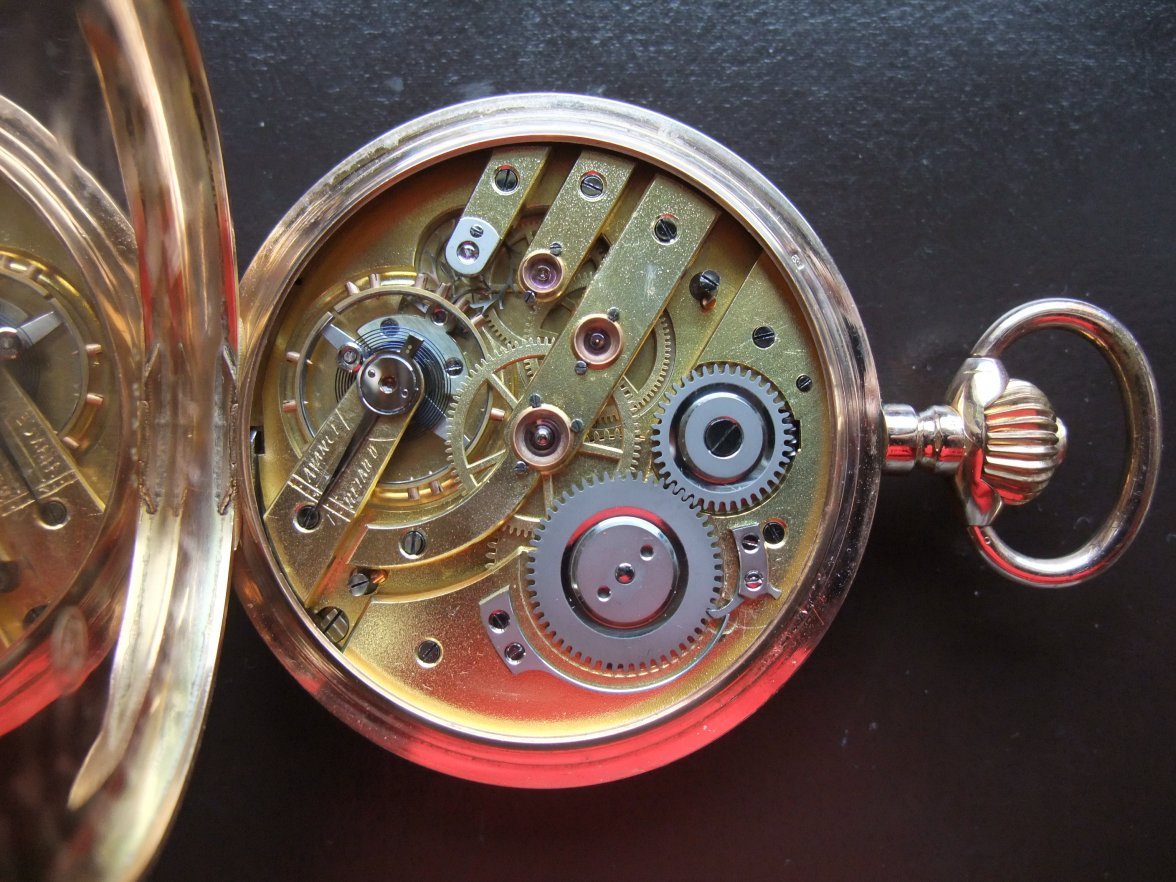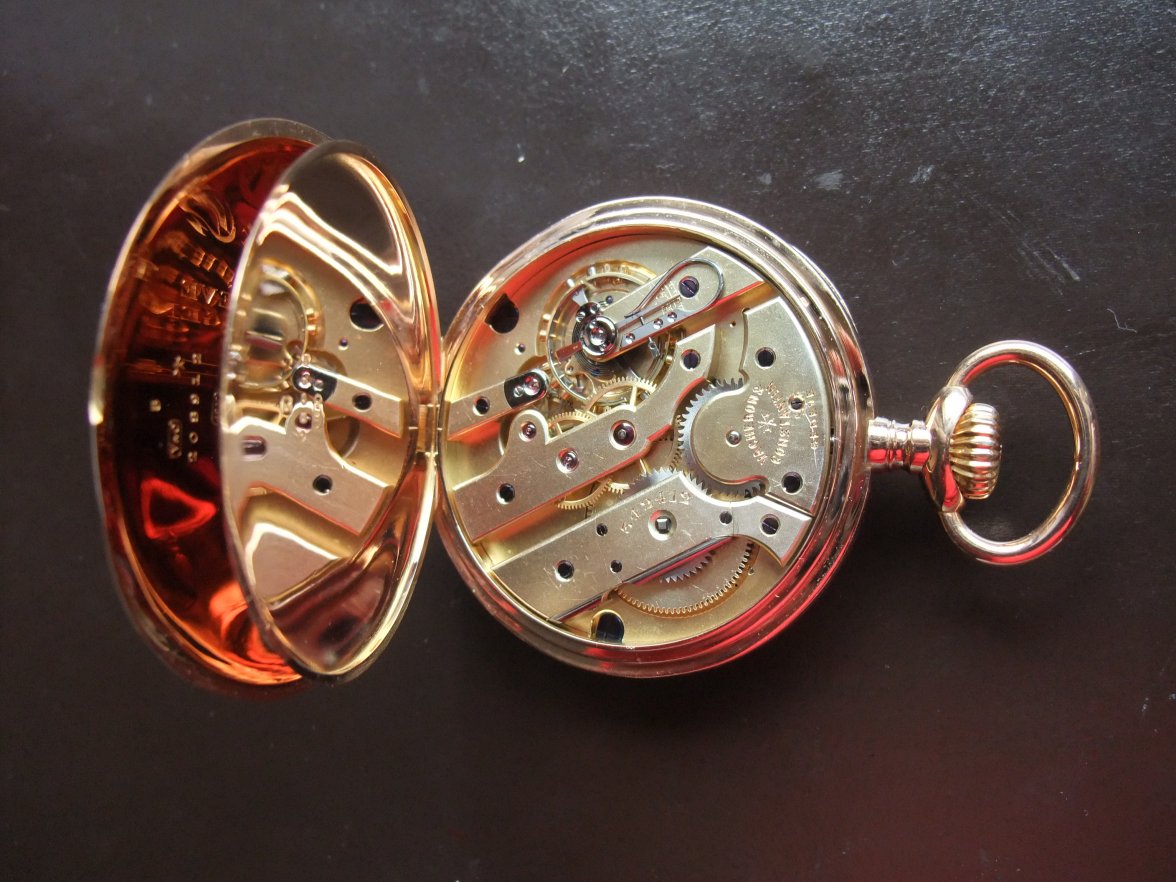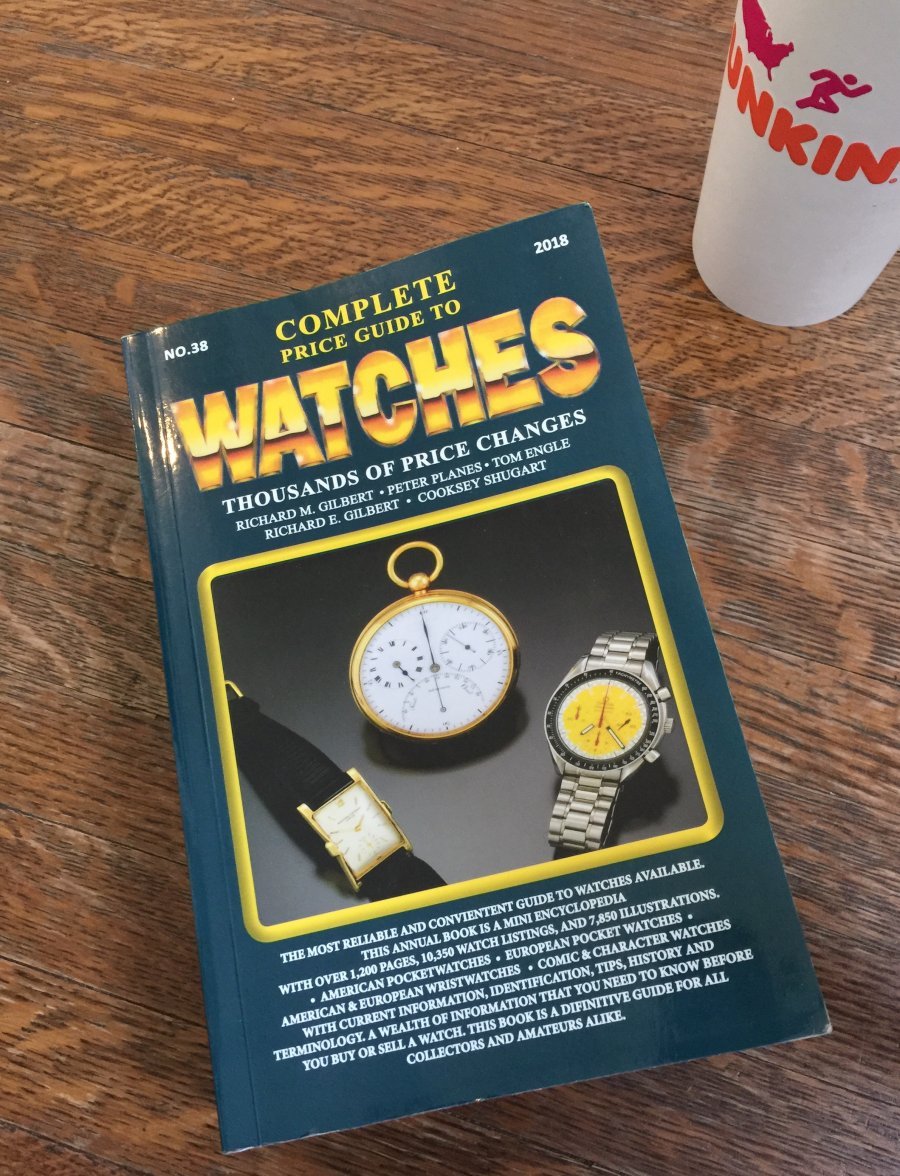Calling all Pocket Watch Buffs
Waltesefalcon
·I almost wore my model 6 Bunn Special today, I wound it up and set it last night then checked my mind this morning. Instead I am wearing my model 9 Bunn Special, this one comes from 1921 wears a "blindman" dial and a pretty heavily worn Dueber case. I'll be sure to wear my model 6 either tomorrow (if I wear a watch) or Monday.
I decided to add a photo, that while isn't very good, shows off the plum colored hands. You'll notice in the first photo that they appear nearly black but in the fourth photo you can see the color show up quite nicely.
I decided to add a photo, that while isn't very good, shows off the plum colored hands. You'll notice in the first photo that they appear nearly black but in the fourth photo you can see the color show up quite nicely.
Edited:
noelekal
··Home For Wayward WatchesCould we entertain a short tutorial on pocket watches?
Y'all have me sucked in. I've been on the outside of pocket watches looking in and only know enough about them to be dangerous. If I'm going down this rabbit hole then I'll need the light of knowledge to negotiate it. I have a security gig at a gun show this weekend and there are generally watches present, including pocket watches. I may look with renewed interest and I need to be "armed." Truth is, most pocket watches I see at the gun shows are overpriced, in poor condition, and of low grade, the sellers not knowledgeable, yet as full as a bull's bum in springtime. Even I'm astute enough to recognize that. But, there might be a "real deal" hidden among the dregs ...
Had a pawnbroker friend/bank customer who years ago told me that the smaller pocket watches were actually considered more high grade, valuable, and collectible than the big ones. That canard doesn't seem to bear out in observations made over a couple of decades of interest.
What sizes do collectors find to be desireable? Are these measurements the size of the movement or the case in which they fit?
Size Inches Millimeters
22s 1 27/30″ (1.9″) 48.26
20s 1 25/30″ (1.83″) 46.56
18s common 1 23/30″ (1.766″) 44.86
17s 1 22/30″ (1.733″) 44.02
16s common 1 21/30″ (1.700″) 43.18
14s 1 19/30″ (1.633″) 41.48
12s common 1 17/30″ (1.566″) 39.78
10s common 1 15/30″ (1.500″) 38.10
8s common 1 13/30″ (1.433″) 36.40
6s common 1 11/30″ (1.366″) 34.70
0s common 1 5/30″ (1.166″) 29.62
3/0s 1 3/30″ (1.100″) 27.94
8/0s 14/15″ (0.933″) 23.71
12/0s 4/5″ (0.800″) 20.32
18/0s 3/5″ (0.600″) 15.24
https://www.keepthetime.com/blog/pocket-watch-size-guide/
Where do both the American and other brands fit on a list ranking the various makers? I perceive that the best vintage Hamiltons are primo stuff. What about Illinois, Waltham and Elgin? Which movements of theirs are best? Are there other worthwhile American brands? What about European brands? I admire both Longines and Omega and have considered adding a pocket watch from one or both to the watch menagerie here.
This thread is from our own Forum.
https://omegaforums.net/threads/who-did-it-better-waltham-elgin-illinois-or-hamilton.14187/page-2
What brands would be best avoided? What movements are most problematic to service? What would be a really good "usin'"vintage pocket watch? Is there such a thing as "minor cracks" in a porcelain dial or are all cracks the kiss of death?
I've long anticipated gathering in a representative specimen Waltham silver cased hunter of the type that resembles my great grandpappy's. Have seen several nice ones on Ebay over the years, but there is nothing outstanding on Ebay right now. There's been a gold filled Hamilton 992B with a Montgomery dial offered for sale at a clock repair shop about an hour from here for a couple of years now. I've considered it on occasion when I'm in there, but haven't "pulled the trigger."
Just for fun.
Saw this watch in the Civil War museum over in Fort Worth. I'm guessing it's of English make. Having enlarged the photograph, my eyes still can't make out the maker.

https://texascivilwarmuseum.com/

Y'all have me sucked in. I've been on the outside of pocket watches looking in and only know enough about them to be dangerous. If I'm going down this rabbit hole then I'll need the light of knowledge to negotiate it. I have a security gig at a gun show this weekend and there are generally watches present, including pocket watches. I may look with renewed interest and I need to be "armed." Truth is, most pocket watches I see at the gun shows are overpriced, in poor condition, and of low grade, the sellers not knowledgeable, yet as full as a bull's bum in springtime. Even I'm astute enough to recognize that. But, there might be a "real deal" hidden among the dregs ...
Had a pawnbroker friend/bank customer who years ago told me that the smaller pocket watches were actually considered more high grade, valuable, and collectible than the big ones. That canard doesn't seem to bear out in observations made over a couple of decades of interest.
What sizes do collectors find to be desireable? Are these measurements the size of the movement or the case in which they fit?
Size Inches Millimeters
22s 1 27/30″ (1.9″) 48.26
20s 1 25/30″ (1.83″) 46.56
18s common 1 23/30″ (1.766″) 44.86
17s 1 22/30″ (1.733″) 44.02
16s common 1 21/30″ (1.700″) 43.18
14s 1 19/30″ (1.633″) 41.48
12s common 1 17/30″ (1.566″) 39.78
10s common 1 15/30″ (1.500″) 38.10
8s common 1 13/30″ (1.433″) 36.40
6s common 1 11/30″ (1.366″) 34.70
0s common 1 5/30″ (1.166″) 29.62
3/0s 1 3/30″ (1.100″) 27.94
8/0s 14/15″ (0.933″) 23.71
12/0s 4/5″ (0.800″) 20.32
18/0s 3/5″ (0.600″) 15.24
https://www.keepthetime.com/blog/pocket-watch-size-guide/
Where do both the American and other brands fit on a list ranking the various makers? I perceive that the best vintage Hamiltons are primo stuff. What about Illinois, Waltham and Elgin? Which movements of theirs are best? Are there other worthwhile American brands? What about European brands? I admire both Longines and Omega and have considered adding a pocket watch from one or both to the watch menagerie here.
This thread is from our own Forum.
https://omegaforums.net/threads/who-did-it-better-waltham-elgin-illinois-or-hamilton.14187/page-2
What brands would be best avoided? What movements are most problematic to service? What would be a really good "usin'"vintage pocket watch? Is there such a thing as "minor cracks" in a porcelain dial or are all cracks the kiss of death?
I've long anticipated gathering in a representative specimen Waltham silver cased hunter of the type that resembles my great grandpappy's. Have seen several nice ones on Ebay over the years, but there is nothing outstanding on Ebay right now. There's been a gold filled Hamilton 992B with a Montgomery dial offered for sale at a clock repair shop about an hour from here for a couple of years now. I've considered it on occasion when I'm in there, but haven't "pulled the trigger."
Just for fun.
Saw this watch in the Civil War museum over in Fort Worth. I'm guessing it's of English make. Having enlarged the photograph, my eyes still can't make out the maker.

https://texascivilwarmuseum.com/

DaveK
·I think if there was a dedicated pocket watch sub forum, we could really curate this info to help collectors
DaveK
·Not all pocket watches belong in your pocket... going back to the dawn of men’s wrist watches, folks continued to convert their pocket watches to a more modern look. Ingersols like this were inexpensive “dollar” watches, but some seemed to hold up despite the odds
I picked up this well used c1920 Ingersol as a model for making a similar strap, now I’m just keeping an eye out for a suitable small watch to make a strap for
I picked up this well used c1920 Ingersol as a model for making a similar strap, now I’m just keeping an eye out for a suitable small watch to make a strap for
DomB
·DomB
·DomB
·Canuck
·America watch sizes:
Let’s start with a “0” size. A Zero, or Ought size America watch is 1 5/30” diameter at the pillar plate (main frame).
Each American “size” increases in diameter by 1/30”. So, a “six” size would be 1 11/30” (that would be 1 5/30” plus 1 6/30” = 1 11/30”). An “eight” size would be 1 13/30”, a “ten” size would be 1 15/30”, or 1 1/2”. A “twelve” size is 1 17/30”, a “fourteen” size, 1 19/30”, a “sixteen” size, 1 21/30”, an “eighteen” size, 1 23/30”. And so it goes with “0” size and up. BUT, American sizes come smaller than ”0” size, as well. So, a 2/0 size (smaller than “0” size) would be 1 3/30”, a 4/0 would be 1 1/30”, a 6/0 would be 29/30”, an 8/0 would be 27/30”, a 10/0 size would be 25/30”. And so it goes. Each size going up, or coming down is 1/30” in diameter, bigger, or smaller. It is simpler to use the comparison size guide found in many collector’s guides which gives the sizes in “lignes “, mm, thousandths, etc. The term “lignes” generally refers to Swiss sizes. The ligne being 1/12 of a French inch! But all this blither aside, case makers 110 years ago tended to produce cases that would accommodate “sizes”, “lignes”, mm, or thousandths. So there was a lot of interchangeability in cases, size-wise.
Your chart is more easily interpreted that mine is.
I have no intention of trying to give you a comprehensive primer on watches. The subject is too large!
What sizes do collectors find desirable? The answer to this question is the same as the solution for leaky bladder. Depends! I focus mainly on 16-size and 18-size. But I have a few 12-size watches as well. But come to that, I have more wrist watches than I do pocket watches. My main focus in pocket watches is American railroad grade, and railroad approved watches, so 16 and 18-size, mainly.
Railroad grade, and railroad approved? An American pocket watch can be either, or. In1850, there were few standards that governed what could be used as a railroad watch. There was no such thing as standard time, either! So how would one govern watch performance in terms of accuracy?
As trains got bigger and faster, and wrecks got more and more expensive, standards changed. Some railroads subscribed to sources such as Western Union which would wire a time source from a central location, to a subscribing railroad to use on their system, regardless of where you happen to be, but only on your own system! This worked fine until someone using time from a different source, wanted to use your track!
You asked a lot of questions, and this is not the best venue for studying what is a huge topic. By reading about the evolution of railroads, the inception of telegraphy in running railroads, the institution of time zones in 1881, the changes in time service rules as to what watches were approved, and standards that were applied to watches, and so on, it is possible to develop a focus re: what you want your collection to represent. Learn by osmosis.
Let’s start with a “0” size. A Zero, or Ought size America watch is 1 5/30” diameter at the pillar plate (main frame).
Each American “size” increases in diameter by 1/30”. So, a “six” size would be 1 11/30” (that would be 1 5/30” plus 1 6/30” = 1 11/30”). An “eight” size would be 1 13/30”, a “ten” size would be 1 15/30”, or 1 1/2”. A “twelve” size is 1 17/30”, a “fourteen” size, 1 19/30”, a “sixteen” size, 1 21/30”, an “eighteen” size, 1 23/30”. And so it goes with “0” size and up. BUT, American sizes come smaller than ”0” size, as well. So, a 2/0 size (smaller than “0” size) would be 1 3/30”, a 4/0 would be 1 1/30”, a 6/0 would be 29/30”, an 8/0 would be 27/30”, a 10/0 size would be 25/30”. And so it goes. Each size going up, or coming down is 1/30” in diameter, bigger, or smaller. It is simpler to use the comparison size guide found in many collector’s guides which gives the sizes in “lignes “, mm, thousandths, etc. The term “lignes” generally refers to Swiss sizes. The ligne being 1/12 of a French inch! But all this blither aside, case makers 110 years ago tended to produce cases that would accommodate “sizes”, “lignes”, mm, or thousandths. So there was a lot of interchangeability in cases, size-wise.
Your chart is more easily interpreted that mine is.
I have no intention of trying to give you a comprehensive primer on watches. The subject is too large!
What sizes do collectors find desirable? The answer to this question is the same as the solution for leaky bladder. Depends! I focus mainly on 16-size and 18-size. But I have a few 12-size watches as well. But come to that, I have more wrist watches than I do pocket watches. My main focus in pocket watches is American railroad grade, and railroad approved watches, so 16 and 18-size, mainly.
Railroad grade, and railroad approved? An American pocket watch can be either, or. In1850, there were few standards that governed what could be used as a railroad watch. There was no such thing as standard time, either! So how would one govern watch performance in terms of accuracy?
As trains got bigger and faster, and wrecks got more and more expensive, standards changed. Some railroads subscribed to sources such as Western Union which would wire a time source from a central location, to a subscribing railroad to use on their system, regardless of where you happen to be, but only on your own system! This worked fine until someone using time from a different source, wanted to use your track!
You asked a lot of questions, and this is not the best venue for studying what is a huge topic. By reading about the evolution of railroads, the inception of telegraphy in running railroads, the institution of time zones in 1881, the changes in time service rules as to what watches were approved, and standards that were applied to watches, and so on, it is possible to develop a focus re: what you want your collection to represent. Learn by osmosis.
tyrantlizardrex
·Was hoping I could find someone who loves bringing watches like this back to life and would do it for a bottle of scotch and a pizza. 😗
I know a guy. He does not work for beer and pizza. 😗
https://www.grandeysplace.co.uk/craftspeople/seth-kennedy
Canuck
·Could we entertain a short tutorial on pocket watches?
Y'all have me sucked in. I've been on the outside of pocket watches looking in and only know enough about them to be dangerous. If I'm going down this rabbit hole then I'll need the light of knowledge to negotiate it. I have a security gig at a gun show this weekend and there are generally watches present, including pocket watches. I may look with renewed interest and I need to be "armed." Truth is, most pocket watches I see at the gun shows are overpriced, in poor condition, and of low grade, the sellers not knowledgeable, yet as full as a bull's bum in springtime. Even I'm astute enough to recognize that. But, there might be a "real deal" hidden among the dregs ...
Had a pawnbroker friend/bank customer who years ago told me that the smaller pocket watches were actually considered more high grade, valuable, and collectible than the big ones. That canard doesn't seem to bear out in observations made over a couple of decades of interest.
What sizes do collectors find to be desireable? Are these measurements the size of the movement or the case in which they fit?
Size Inches Millimeters
22s 1 27/30″ (1.9″) 48.26
20s 1 25/30″ (1.83″) 46.56
18s common 1 23/30″ (1.766″) 44.86
17s 1 22/30″ (1.733″) 44.02
16s common 1 21/30″ (1.700″) 43.18
14s 1 19/30″ (1.633″) 41.48
12s common 1 17/30″ (1.566″) 39.78
10s common 1 15/30″ (1.500″) 38.10
8s common 1 13/30″ (1.433″) 36.40
6s common 1 11/30″ (1.366″) 34.70
0s common 1 5/30″ (1.166″) 29.62
3/0s 1 3/30″ (1.100″) 27.94
8/0s 14/15″ (0.933″) 23.71
12/0s 4/5″ (0.800″) 20.32
18/0s 3/5″ (0.600″) 15.24
https://www.keepthetime.com/blog/pocket-watch-size-guide/
Where do both the American and other brands fit on a list ranking the various makers? I perceive that the best vintage Hamiltons are primo stuff. What about Illinois, Waltham and Elgin? Which movements of theirs are best? Are there other worthwhile American brands? What about European brands? I admire both Longines and Omega and have considered adding a pocket watch from one or both to the watch menagerie here.
This thread is from our own Forum.
https://omegaforums.net/threads/who-did-it-better-waltham-elgin-illinois-or-hamilton.14187/page-2
What brands would be best avoided? What movements are most problematic to service? What would be a really good "usin'"vintage pocket watch? Is there such a thing as "minor cracks" in a porcelain dial or are all cracks the kiss of death?
I've long anticipated gathering in a representative specimen Waltham silver cased hunter of the type that resembles my great grandpappy's. Have seen several nice ones on Ebay over the years, but there is nothing outstanding on Ebay right now. There's been a gold filled Hamilton 992B with a Montgomery dial offered for sale at a clock repair shop about an hour from here for a couple of years now. I've considered it on occasion when I'm in there, but haven't "pulled the trigger."
Just for fun.
Saw this watch in the Civil War museum over in Fort Worth. I'm guessing it's of English make. Having enlarged the photograph, my eyes still can't make out the maker.
https://texascivilwarmuseum.com/

i am unable to read the name of the maker of the Civil War pocket watch, either. Or his location. I wonder why the museum curator would not include that info in the display!
Canuck
·Here is another mystery watch from
My childhood collection- my father gave this to me when I had my Bar Mitzvah. Anyone know what this is?
Watches in the era of yours were produced by the “craft” method, generally. A number of separate specialty makers made components, the parts being assembled by a “finisher” who assembled to parts into a running watch. Unlike the American system where the raw material was deliver to one for, and days later, a finished watch was shipped out a different door. It was easy to know who had a hand in making the watch. Your watch is seemingly Swiss, and a very fine grade. But it would take a sharp eye to discern the maker. I am no help. But it would appear to me to be circa the last quarter of the 19th century.
Oku
·Could we entertain a short tutorial on pocket watches?
A short tutorial is difficult, but let's try it.
But before, I have to say, that being a European guy, I am not into American watches. So all my remarks are related to European, mostly Swiss and English watches.
Size: The bigger the better. Mostly. But not always. When it's not wearable anymore, bigger is not better anymore.
In the early days of watchmaking, accuracy was most important. Only big balances were considered to guarantee accuracy. So accurate watches have a balance as big as possible. Also thickness plays a role. Thin watches often behave like little divas. Thicker movements were more reliable. But note the manufacturers competed in making the thinnest watches. So thin watches can be interesting.
Weight: Usually, heavy watches are more valuable as the cases have more gold. You should avoid those thin cases that can easily be deformed with your thumb. These watches usually are neither high grade nor rare.
Is there such a thing as "minor cracks" in a porcelain dial or are all cracks the kiss of death?
Movement: The more screwed gold chatons, the better.
Compare this simple movement
with this one:
However, also movements without gold chatons are valuable. Look at this Chronometre Royal (Vacheron):
What brands would be best avoided? What movements are most problematic to service? What would be a really good "usin'"vintage pocket watch?
Old pocket watch brands are often dead and unknown to most people. Who knows Huguenin, Arnold, Thomas Tompion or Nicole Nielsen nowadays? But the watches are nonetheless great and very valuable. Imho, they are way more interesting than an Omega pocket watch.
If you intend to wear a pocket watch, it is important to get it serviced. Otherwise, you risk wear and damage.
Simple pocket watches without any complication can mostly be worn. But I would avoid cylinder escapements, as they are usually less accurate.
Concerning the case material, most collectors prefer gold or silver, but not plated. There are so many pocket watches around, why going with gold plated when yo can have solid gold?
Hope this helps a bit.
Mad Dog
·@noelekal...the first 100 pages of the Complete Price Guide to Watches contains some pretty good info regarding pocket watches in my humble opinion...and I would say that American pocket watches are emphasized. This book is published yearly and is available at most book stores. Following the first 100 pages is a handy valuation/price guide for pocket watches...and a handy valuation/price guide for wrist watches follows the pocket watches.
LATE ENTRY: I just learned from @140dave that the Complete Price Guide to Watches is no longer being published.
LATE ENTRY: I just learned from @140dave that the Complete Price Guide to Watches is no longer being published.
Edited:
JwRosenthal
·@noelekal...the first 100 pages of the Complete Price Guide to Watches contains some pretty good info regarding pocket watches in my humble opinion...and I would say that American pocket watches are emphasized. This book is published yearly and is available at most book stores. Following the first 100 pages is a handy valuation/price guide for pocket watches...and a handy valuation/price guide for wrist watches follows the pocket watches.
Mad Dog
·What is a “book store”?
140dave
·Hate to be the one to break the news but the Shugart guide is no longer being published. They did a "final" year before last. 🙁
